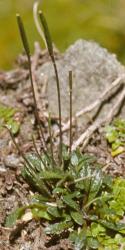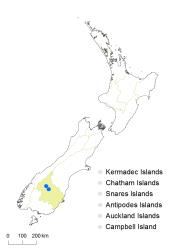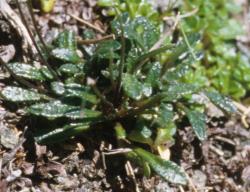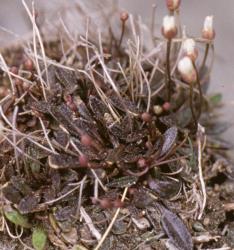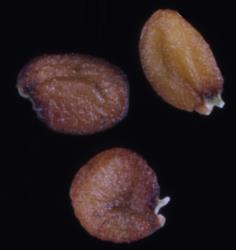Perennial herb, single rosette or with short lateral branches, stem and branches c. 2 mm diam. Leaves up to 17(–45) mm long, simple, glabrous or hairy; lamina 5–20 × 2–5 mm, narrowly obovate to spathulate, glossy, coriaceous, green, brown-green to bronze, glabrous on abaxial surface, glabrous or sparsely to moderately hairy on margin and adaxial surface; apex obtuse, often with a distinct hydathode; base cuneate to attenuate, grading into petiole; hairs unicellular, straight or curved, transparent. Petiole up to 12(–25) mm long, plano-convex, usually glabrous although sometimes 1–3 hairs on margin. Cauline leaves occasional, similar to rosette leaves but smaller. Inflorescence corymbose with 2–8 flowers, flowers sometimes solitary, peduncle up to 30(–70) mm long, 0.7–0.8 mm diam. at base, upright, glossy, glabrous, green to brown-green. Pedicels up to 30 mm long, 0.5 mm diam., flexuose. Sepals 1.6–1.8 × 0.7–1.0 mm, oblong to oval, ± saccate, green, glabrous or with occasional simple hairs, margin white and membranous, apex obtuse, base truncate. Petals 2.1–3.2 × 1.2–1.3 mm, white, limb obovate to oblong; apex obtuse; base attenuate, tapering into the ± indistinct claw. Stamens 4–6; filaments 1.2–1.3 mm long; anthers 0.4–0.5 mm long, yellow, held at a similar height to or slightly overtopping the stigma. Ovary 1.8–2.0 mm long, c. 0.6 mm diam., ± terete, green, glabrous; ovules 13–14 in each locule; style 0.3–0.4 mm long, ± terete; stigma 0.4–0.5 mm diam. Siliques 7–14 × 1.4–1.5 mm, erect, glabrous, valves green at maturity, style 0.7–0.8 mm long. Seeds 1.0–1.1 mm long, 0.8–0.9 mm wide, 0.3–0.5 mm thick, oblong, orbicular-oblong to orbicular, pale yellow; wing absent.
Cardamine sciaphila is distinguished from C. alticola by its glossy, narrow and coriaceous leaves, which are often hairy, shorter petioles, and its petals being 2.1–3.2 mm long.
South Island: Otago.
Cardamine sciaphila is known from the highest parts of the Dunstan Mountains (1600 m) and Pisa Range (1620–1850 m) in Central Otago.
Cardamine sciaphila occurs among low-growing herbs and grasses on ledges and crevices of rock tors, outcrops, and bluffs, showing a clear preference for shaded sites. Plants are often difficult to find unless in flower as they are often buried among other herbaceous vegetation.
Cardamine sciaphila is assessed as having a conservation status of Threatened, Nationally Critical A(1), with the qualifiers Range Restricted and Data Poor (de Lange et al. 2018). The qualifier Data Poor is applied because there is suitable alpine habitat for this species on the plateau mountains of Central Otago and field survey is likely to locate additional populations.
Flowering December–January; Fruiting January–March.
Plants from the Dunstan Mountains have a conspicuously hairy leaf lamina, whereas the lamina of plants from the Pisa Range are very sparsely hairy, glabrate or glabrous. Few flowers were available for study, but a plant from the Pisa Range (CHR 580889) had two flowers that had only four stamens, whereas plants from Dunstan Mountains had six stamens. Further taxonomic research on variation of the leaf and flower characters is required.
Previously known by the tagname C. “Pisa Range” (e.g., de Lange et al. 2013).



